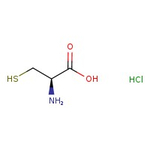Search Thermo Fisher Scientific
Thermo Scientific Chemicals
L-Cysteine hydrochloride, anhydrous, 98%
L-cysteine hydrochloride , CAS# 7048-04-6, also known as L-cysteine hydrochloride monohydrate, is a soluble salt of the non-essential amino acid, L-cysteine. It is commonly used as a nucleophile in several chemical reactions. | CAS: 52-89-1 | C3H8ClNO2S | 157.61 g/mol
| Catalog Number | Quantity |
|---|---|
| ALFL06328.22 | 100 g |
Catalog number ALFL06328.22
View Price:Sign InSign in to see your account pricing. Need an account? Register with us today.
Quantity:
100 g
Specifications
Chemical Name or MaterialL-Cysteine hydrochloride
Melting Point∽180°C (decomposition)
Name Noteanhydrous
CAS52-89-1
Health Hazard 1H315-H319-H335
View more
L-Cysteine hydrochloride, anhydrous is widely used as additive in food production. It is used as an antioxidant to promote fermentation and keep the flavor. It is also used in cosmetics and animal feed.
This Thermo Scientific Chemicals brand product was originally part of the Alfa Aesar product portfolio. Some documentation and label information may refer to the legacy brand. The original Alfa Aesar product / item code or SKU reference has not changed as a part of the brand transition to Thermo Scientific Chemicals.
General Description
- L-cysteine hydrochloride is a non-essential proteinogenic amino acid commonly used in chemical reactions, for instance, the thiol side chain in cysteine often participates in enzymatic reactions as a nucleophile.
Application
- L-cysteine hydrochloride plays an important role as a histidine ammonia-lyase inhibitor with the ability to interfere with the action of histidine ammonia-lyase.
- In chemical reactions, L-cysteine hydrochloride is used as a raw material for the production of S-carboxymethyl-L-cysteine, L-cysteine base, and N-acetyl-L-cysteine.
- This compound also has antioxidant activity.
- It has been used in laboratory protocols to separate dorsal root ganglion neurons.
- This compound is applied to study the inhibitory effect of L-cysteine hydrochloride hydrate in preventing enzymatic browning in apples.
RUO – Research Use Only
General References:
- Richard, F.; Goupy, P.; Nicolas, J.; Lacombe, J.; Pavia, A. Cysteine as an inhibitor of enzymic browning. 1. Isolation and characterization of addition compounds formed during oxidation of phenolics by apple polyphenol oxidase. J. Agric. Food Chem. 1991, 39, 5, 841–847.
- Zuchero, J. Purification of Dorsal Root Ganglion Neurons from Rat by Immunopanning. Cold Spring Harb Protoc. 2014, 2014, (8), 826–838.
- Prasad, P. V.; Rao, T. V.; Rao, K. R.; Kamal, C. S.; Samuel, T. Studies on influence of Cd 2+ ions in unidirectional growth and characterization of l-Cysteine hydrochloride monohydrate single crystals. Spectrochim. Acta, Part A 2015, 136, 1950-1954.
- Koohyar, F.; Rostami, A. A.; Chaichi, M. J.; Kiani, F. Refractive indices, viscosities, and densities for l-cysteine hydrochloride monohydrate+ D-sorbitol+ water, and glycerol+ D-sorbitol+ water in the temperature range between T= 303.15 K and T= 323.15 K. 2011, 40 (7), 1361-1370.



